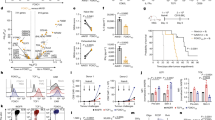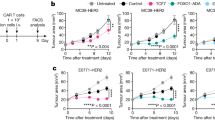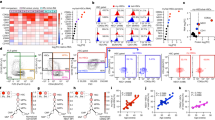Abstract
The immune system must distinguish not only between self and non-self, but also between innocuous and pathological foreign antigens to prevent unnecessary or self-destructive immune responses. Unresponsiveness to harmless antigens is established through central and peripheral processes1. Whereas clonal deletion and anergy are mechanisms of peripheral tolerance2,3, active suppression by T-regulatory 1 (Tr1) cells has emerged as an essential factor in the control of autoreactive cells4. Tr1 cells are CD4+ T lymphocytes that are defined by their production of interleukin 10 (IL-10)5 and suppression of T-helper cells6; however, the physiological conditions underlying Tr1 differentiation are unknown. Here we show that co-engagement of CD3 and the complement regulator CD46 in the presence of IL-2 induces a Tr1-specific cytokine phenotype in human CD4+ T cells. These CD3/CD46-stimulated IL-10-producing CD4+ cells proliferate strongly, suppress activation of bystander T cells and acquire a memory phenotype. Our findings identify an endogenous receptor-mediated event that drives Tr1 differentiation and suggest that the complement system has a previously unappreciated role in T-cell-mediated immunity and tolerance.
This is a preview of subscription content, access via your institution
Access options
Subscribe to this journal
Receive 51 print issues and online access
$199.00 per year
only $3.90 per issue
Buy this article
- Purchase on Springer Link
- Instant access to full article PDF
Prices may be subject to local taxes which are calculated during checkout




Similar content being viewed by others
References
Van Parijs, A. & Abbas, A. K. Homeostasis and self-tolerance in the immune system: turning lymphocytes off. Science 280, 243–248 (1998)
Kappler, J. W., Roehm, N. & Marrack, P. T cell tolerance by clonal elimination in the thymus. Cell 49, 273–280 (1987)
Kisielow, P., Bluthmann, H., Staerz, U. D., Steinmetz, M. & von Boehmer, H. Tolerance in T-cell-receptor transgenic mice involves deletion of nonmature CD4+8+ thymocytes. Nature 333, 742–746 (1988)
Sakaguchi, S. Regulatory T cells: key controllers of immunologic self-tolerance. Cell 101, 455–458 (2000)
Groux, H. et al. A CD4+ T-cell subset inhibits antigen-specific T-cell responses and prevents colitis. Nature 389, 737–742 (1997)
Roncarolo, M. G. & Levings, M. K. The role of different subsets of T regulatory cells in controlling autoimmunity. Curr. Opin. Immunol. 12, 676–683 (2000)
LeDouarin, N. et al. Evidence for a thymus-dependent form of tolerance that is not based on elimination or anergy of reactive T cells. Immunol. Rev. 149, 35–53 (1996)
Shevach, E. M. Regulatory T cells in autoimmunity. Annu. Rev. Immunol. 18, 423–449 (2000)
Shevach, E. M. S. M. R., Piccirillo, C. A. & Thornton, A. M. Control of T-cell activation by CD4+CD25+ suppressor T cells. Immunol. Rev. 182, 58–67 (2001)
Chen, Y., Kuchroo, V. K., Inobe, J., Hafler, D. A. & Weiner, H. L. Regulatory T cell clones induced by oral tolerance: suppression of autoimmune encephalomyelitis. Science 265, 1237–1240 (1994)
Roncarolo, M. G., Bacchetta, R., Bordignon, C., Narula, S. & Levings, M. K. Type 1 regulatory cells. Immunol. Rev. 182, 68–79 (2001)
Barrat, F. J. et al. In vitro generation of interleukin 10-producing regulatory CD4+ T cells is induced by immunosuppressive drugs and inhibited by T helper type 1 (Th1)- and Th2-inducing cytokines. J. Exp. Med. 195, 603–616 (2002)
Cole, J. L., Housley, G. A. Jr, Dykman, T. R., MacDermott, R. P. & Atkinson, J. P. Identification of an additional class of C3-binding membrane proteins of human peripheral blood leukocytes and cell lines. Proc. Natl Acad. Sci. USA 82, 859–863 (1985)
Liszewski, M. K., Post, T. W. & Atkinson, J. P. Membrane cofactor protein (MCP or CD46): newest member of the regulators of complement activation gene cluster. Annu. Rev. Immunol. 9, 431–455 (1991)
Dorig, R. E., Marcil, A., Chopra, A. & Richardson, C. D. The human CD46 molecule is a receptor for measles virus (Edmonston strain). Cell 75, 295–305 (1993)
Naniche, D. et al. Human membrane cofactor protein (CD46) acts as a cellular receptor for measles virus. J. Virol. 67, 6025–6032 (1993)
Santoro, F. et al. CD46 is a cellular receptor for human herpes virus 6. Cell 99, 817–827 (1999)
Okada, N., Liszewski, M. K., Atkinson, J. P. & Caparon, M. Membrane cofactor protein (MCP; CD46) is a keratinocyte receptor for the M protein of group A streptococcus. Proc. Natl Acad. Sci. USA 92, 2489–2493 (1995)
Kallstrom, H., Liszewski, M. K., Atkinson, J. P. & Jonsson, A.-B. Membrane cofactor protein (MCP or CD46) is a cellular pilus receptor for pathogenic Neisseria. Mol. Microbiol. 25, 639–647 (1997)
Karp, C. L. et al. Mechanism of suppression of cell-mediated immunity by measles virus. Science 273, 228–231 (1996)
Kallstrom, H., Islam, M. S., Berggren, P. O. & Jonsson, A. B. Cell signaling by the type IV pili of pathogenic Neisseria. J. Biol. Chem. 273, 21777–21782 (1998)
Astier, A., Trescol-Biemont, M.-C., Azocar, O., Lamouille, B. & Rabourdin-Combe, C. Cutting edge: CD46, a new costimulatory molecular for T cells, that induces p120CBL and LAT phosphorylation. J. Immunol. 164, 6091–6095 (2000)
Wang, G., Liszewski, M. K., Chan, A. C. & Atkinson, J. P. Membrane cofactor protein (MCP; CD46): isoform-specific tyrosine phosphorylation. J. Immunol. 164, 1839–1846 (2000)
Marie, J. et al. Linking innate and acquired immunity: divergent role of CD46 cytoplasmic domains in T cell-induced inflammation. Nature Immunol. 3, 659–666 (2002)
Nielsen, C. H., Fischer, E. M. & Leslie, R. G. The role of complement in the acquired immune response. Immunology 100, 4–12 (2000)
Dempsey, P. W., Allison, M. E., Akkaraju, S., Goodnow, C. C. & Fearon, D. T. C3d of complement as a molecular adjuvant: bridging innate and acquired immunity. Science 271, 348–350 (1996)
Prodeus, A. P. et al. A critical role for complement in maintenance of self-tolerance. Immunity 9, 721–731 (1998)
McGuirk, P. & Mills, K. H. G. Pathogen-specific regulatory T cells provoke a shift in the Th1/Th2 paradigm in immunity to infectious diseases. Trends. Immunol. 23, 450–455 (2002)
Liszewski, M. K. et al. Dissecting sites important for complement regulatory activity in membrane cofactor protein (MCP; CD46). J. Biol. Chem. 275, 37692–37701 (2001)
Krych-Goldberg, M. et al. Decay accelerating activity of complement receptor type 1 (CD35). J. Biol. Chem. 274, 31160–31168 (1999)
Acknowledgements
We thank H. Molina, K. Liszewski, L. S. Wen and M. Denny for comments on the manuscript, and the immunology community at Washington University School of Medicine for discussions.
Author information
Authors and Affiliations
Corresponding author
Ethics declarations
Competing interests
The authors declare that they have no competing financial interests.
Supplementary information
Rights and permissions
About this article
Cite this article
Kemper, C., Chan, A., Green, J. et al. Activation of human CD4+ cells with CD3 and CD46 induces a T-regulatory cell 1 phenotype. Nature 421, 388–392 (2003). https://doi.org/10.1038/nature01315
Received:
Accepted:
Issue Date:
DOI: https://doi.org/10.1038/nature01315
This article is cited by
-
Gliosis-dependent expression of complement factor H truncated variants attenuates retinal neurodegeneration following ischemic injury
Journal of Neuroinflammation (2024)
-
Immunologic and Genetic Contributors to CD46-Dependent Immune Dysregulation
Journal of Clinical Immunology (2023)
-
Lupus nephritis with corticosteroid responsiveness: molecular changes of CD46-mediated type 1 regulatory T cells
Pediatric Research (2022)
-
Complement in metabolic disease: metaflammation and a two-edged sword
Seminars in Immunopathology (2021)
-
Simultaneous quantification of natural and inducible regulatory T-cell subsets during interferon-β therapy of multiple sclerosis patients
Journal of Translational Medicine (2020)
Comments
By submitting a comment you agree to abide by our Terms and Community Guidelines. If you find something abusive or that does not comply with our terms or guidelines please flag it as inappropriate.



